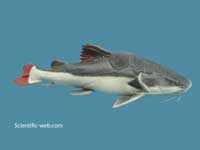Phractocephalus hemioliopterus
The redtail catfish, Phractocephalus hemioliopterus, is a pimelodid (long-whiskered) catfish named for its red or orange caudal fin. In Venezuela it is known as cajaro and in Brazil it is known as pirarara.[1] It is the only extant species of the genus Phractocephalus. This fish originates from South America. Despite reaching a large size, this fish is a common aquarium fish. Extinct Phractocephalus Although the redtail catfish is the only living representative of this genus, there are other members that date back to the upper Miocene. P. nassi was described in 2003, and is from Urumaco, Venezuela. Another undescribed member is known to exist from Acre, Brazil.[1] This genus has a minimum age of about 13.5 million years.[1] Distribution and Habitat The redtail catfish is native to the Amazon, Orinoco, and Essequibo river basins of South America.[1] It is found only in fresh water.[2] This fish has also been introduced into Florida, but it is not established.[2] Anatomy The redtail catfish has a broad head with a wide mouth. Its body is primarily dark gray with small darker gray spots. The ventral surface is paler. The redtail catfish has three pairs of long barbels. A lateral white band starts at the caudal peduncle and runs anteriorly, tapering to end anywhere from midway along the body to just behind the operculum. The caudal fin is red or orange, giving the fish its common name. The juveniles may be more intensely colored. Upon maturity these fish can reach a length of 1.3 m (4 ft) total length. They have been known to reach over 44 kg (97 lb).[2] Relationship to humans Because of the large size this fish can reach, it is a popular game fish.[2] The world record belongs to the Brazilian Jorge Masullo de Aguiar with 51.5 Kg. It is said that the natives do not eat the meat of the Redtail catfish because it is black in coloration. [3] However, the redtail catfish has been hybridized with other fish such as the Tiger Shovelnose Pseudoplatystoma sp. through the use of hormones in attempts to create a viable food fish; these hybrid fish sometimes make it into the aquarium hobby under a variety of common names.[4] In the aquarium The redtail catfish is an extremely popular fish in Amazonian themed exhibits at public aquaria, where they are often housed with other large fish such as Colossoma macropomum, Arapaima gigas, and other large catfish. Juveniles are often available as aquarium fish despite their eventual large size. In an aquarium where they may be well-fed, these fish can grow quite rapidly.[3] Weekly feeding is appropriate for this catfish; overfeeding is a common cause of death in this species.[4]It feeds heavily on live and dead fishes and other meat. Even as a juvenile of only a few inches in length, they are able to swallow many of the more common aquarium fish such as tetras, and it is only appropriate to house this fish with other species of relatively large size. Redtail catfish also have a habit of swallowing inedible objects in the aquarium, though these are often regurgitated. Both the swallowing and the regurgitation can present a problem for the fish, and objects are best kept out of the aquarium.[4] See also * List of freshwater aquarium fish species References
Retrieved from "http://en.wikipedia.org/" |
|

